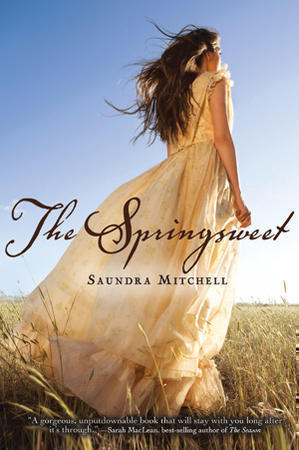 “The Springsweet” by Saundra Mitchell, Harcourt Children’s Books, April 17, 2012, $16.99 (ages 12 and up)
“The Springsweet” by Saundra Mitchell, Harcourt Children’s Books, April 17, 2012, $16.99 (ages 12 and up)
Since the tragic death of her fiancé, Thomas, 17-year-old Zora has been going through the motions. She doesn’t know what she wants to do with her life, but she does know there’s nothing left for her in Baltimore. When her mother finds out Zora has been applying to be a mail-order bride, she puts her foot down. She offers Zora a different option — move to the frontier town of West Glory, Okla., to help her aunt Birdie and younger cousin Louella with their homestead.
Zora goes along with her mother’s wishes, but she doesn’t plan on “coming to her senses” anytime soon. But Zora’s arrival brings with it a lot of scrutiny — there aren’t many single, pretty young women on the frontier, and Zora attracts a number of followers, new and old.
However, what really catches people’s attention is Zora’s newly found ability to sense water deep under the parched soil. People are desperate for water, and Birdie thinks Zora’s gift could make their lives much easier. Hired out as a “springsweet,” Zora goes from homestead to homestead, advising desperate settlers where to dig their much-needed wells. Holding the key to so many people’s survival is a burden Zora is unprepared for. Zora feels as if she’s awakening, but at what cost?
“The Springsweet” is a companion novel to “The Vespertine,” and I didn’t realize this until I had begun reading. “The Vespertine” has been on my “to-read” list since it came out, and after reading “The Springsweet” it’s jumped a few notches up on the list. While there are references to “The Vespertine,” it’s not imperative that readers have read it first. Though, the background would have helped make more sense of some things up front.
Author Saundra Mitchell is a natural storyteller. Her words flow smoothly, as does her story. “The Springsweet” is a fast read — partly because it’s a relatively short book at less than 300 pages and partly because of Saundra’s pacing. Saundra sets a great scene, with lyrical imagery that transports her readers. And while I found the eventual outcome somewhat predictable, I didn’t mind in the least.
“The Springsweet” evokes a different time and place. There’s a sense of history that gives weight to the more “magical” moments weaved throughout the book. It’s definitely worth giving up a couple hours to read.
